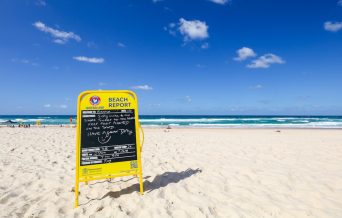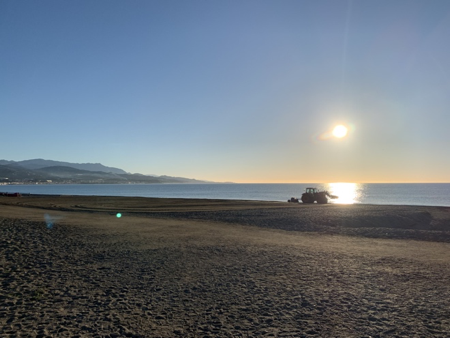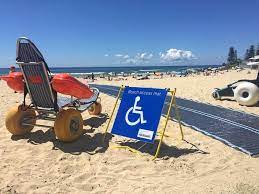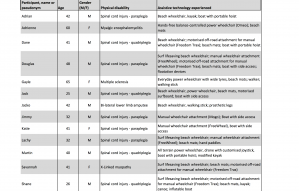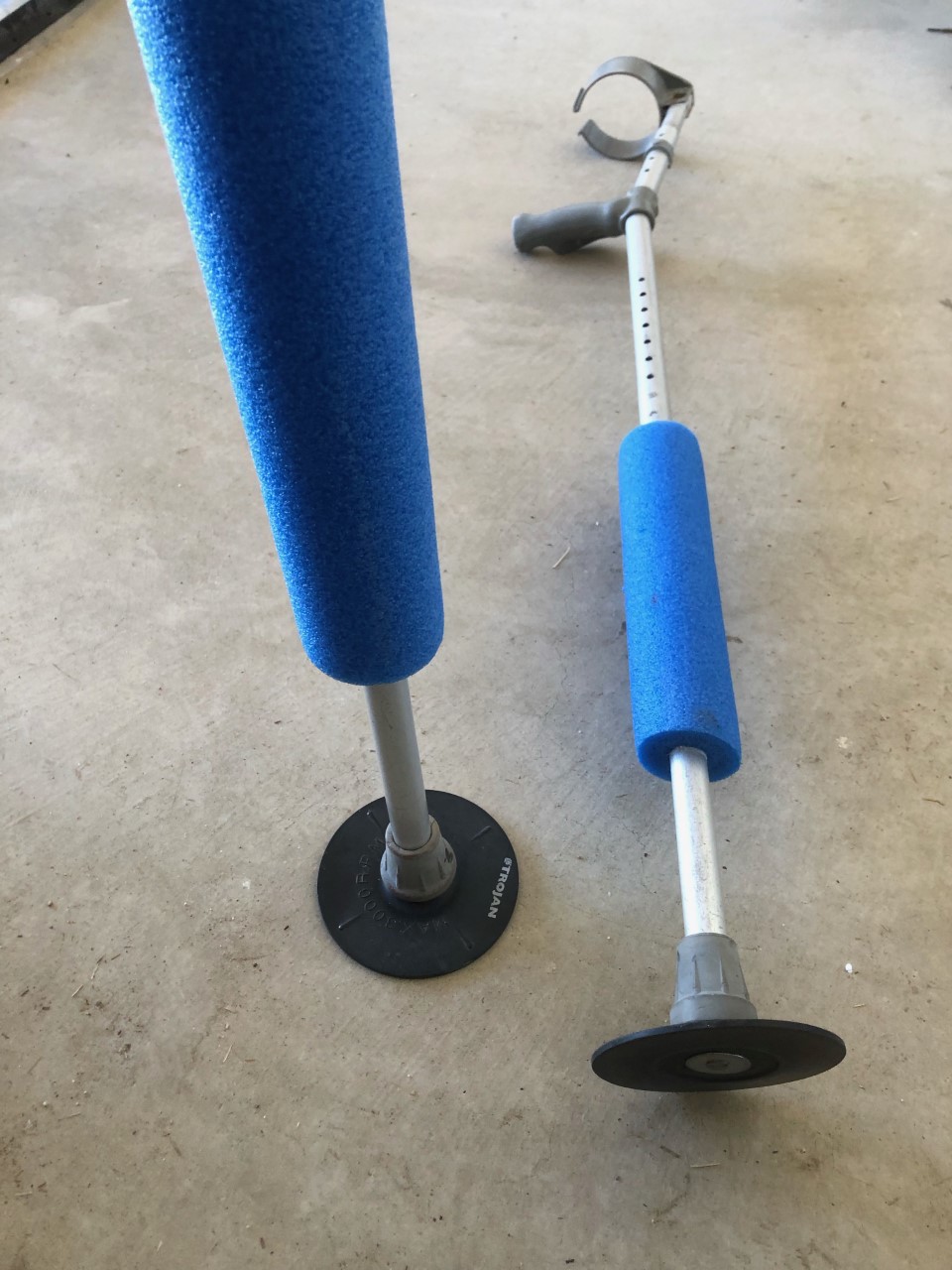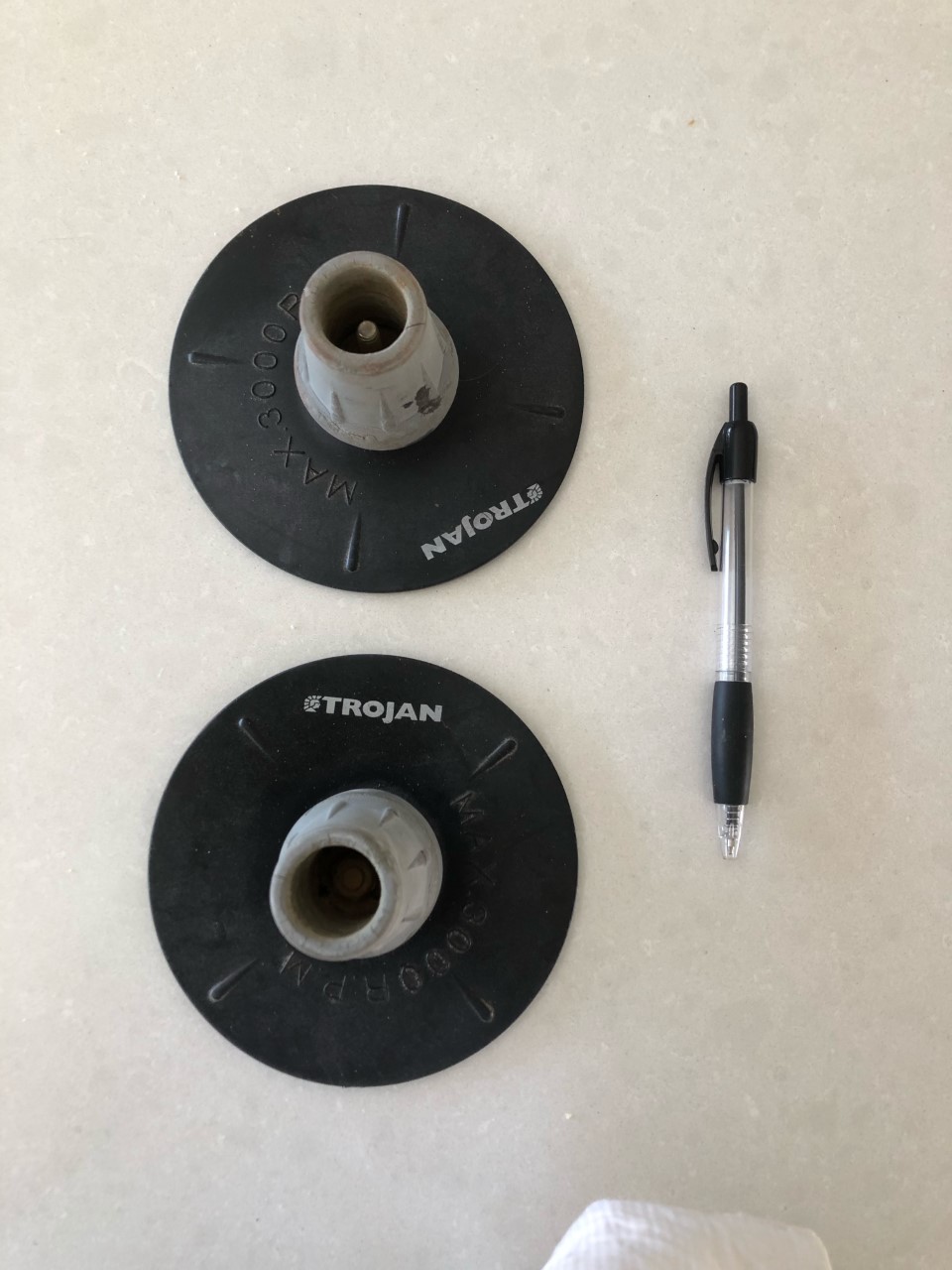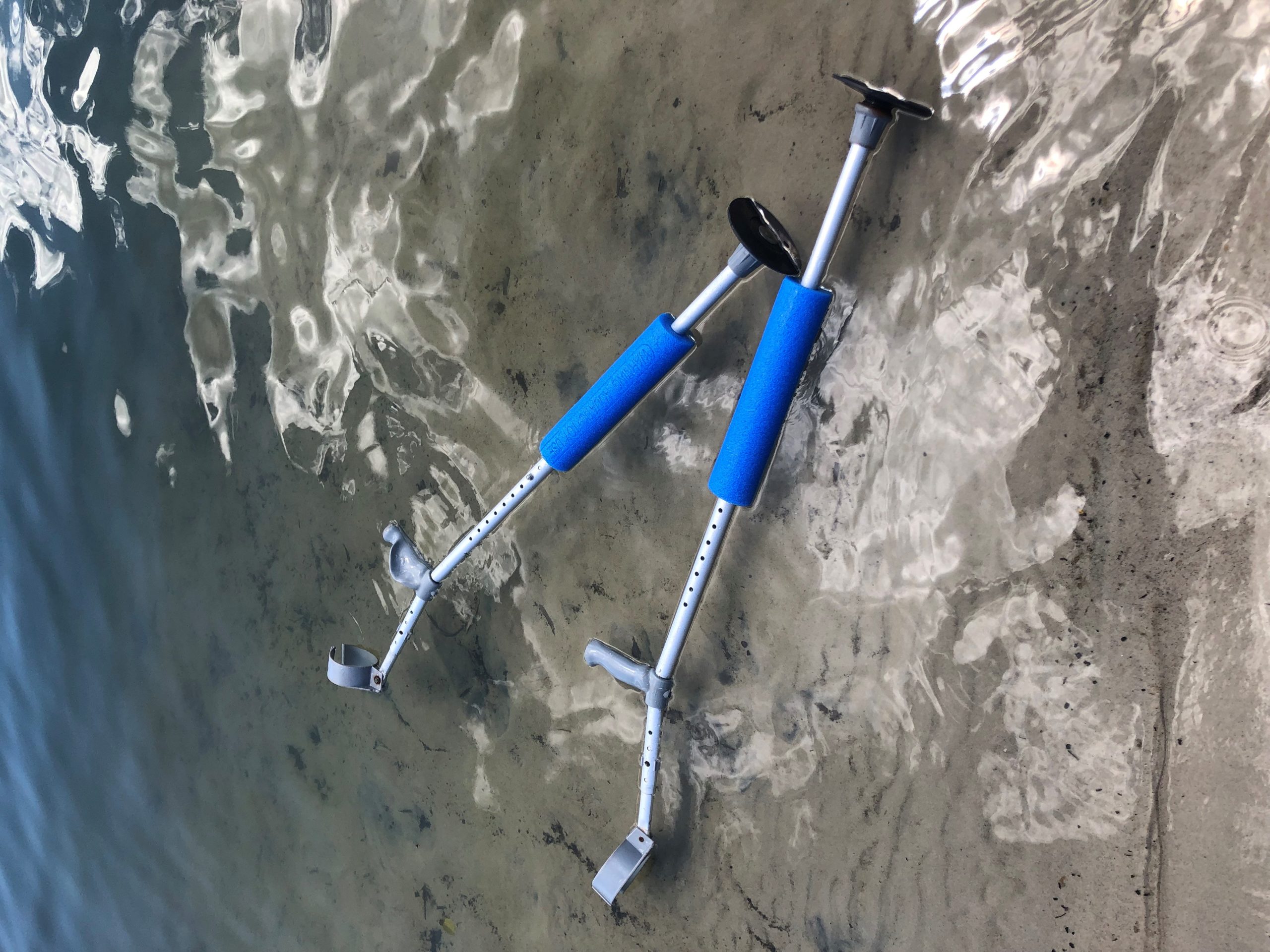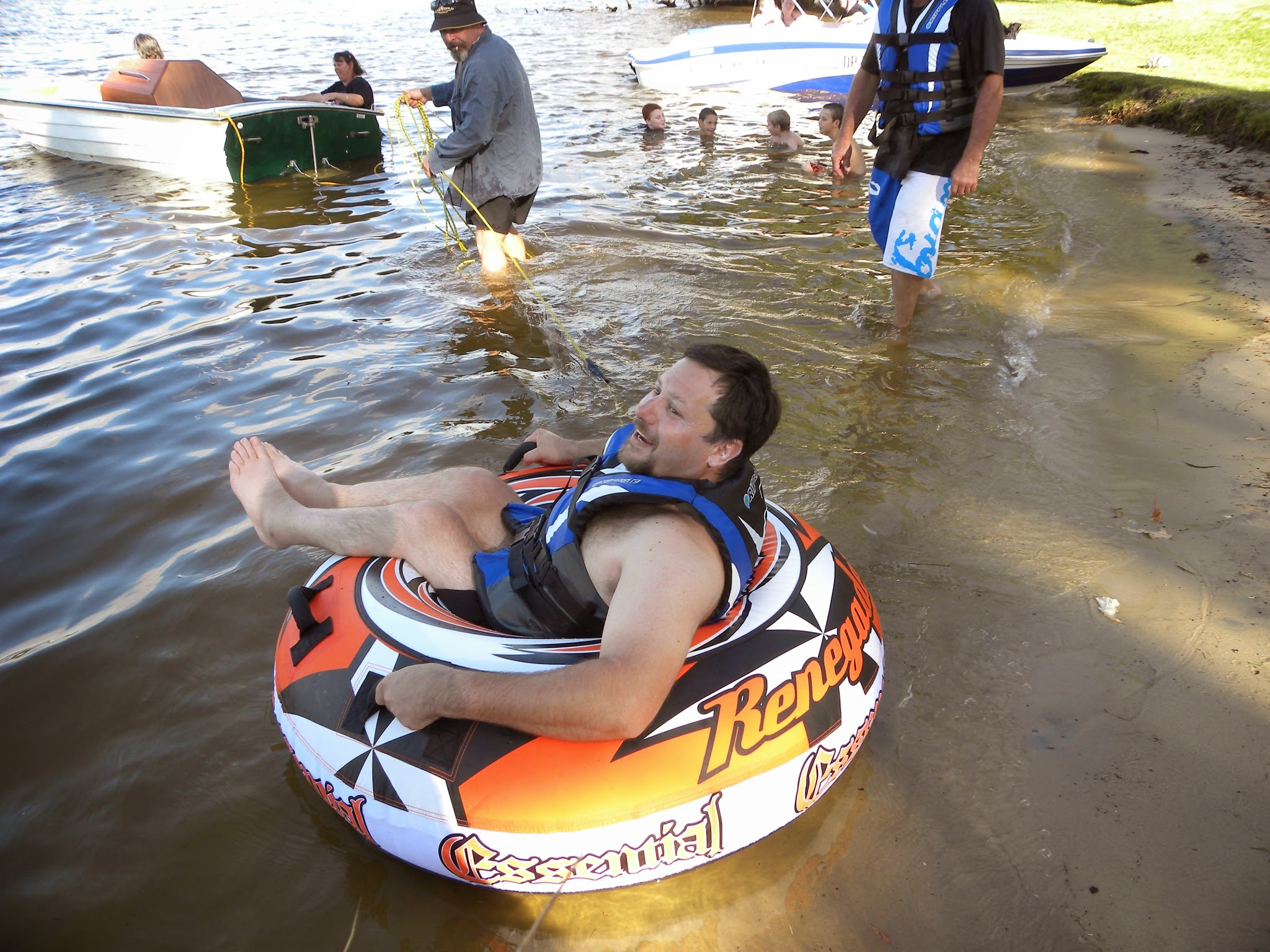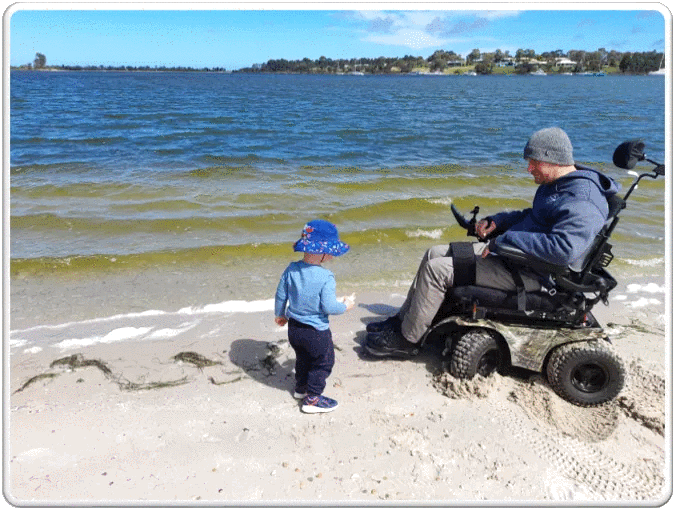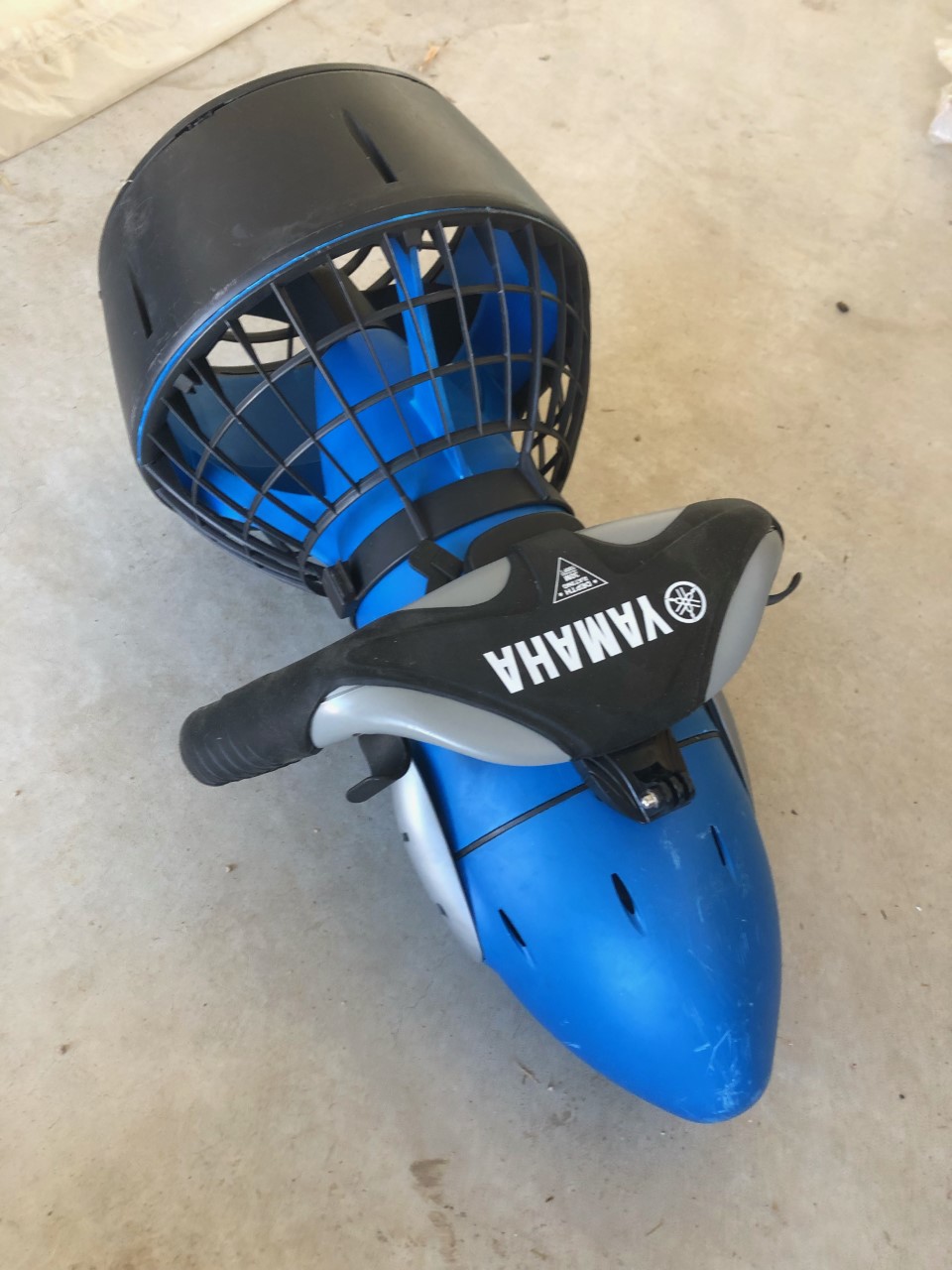LIFE TAKES YOU DOWN MANY PATHS, BUT THE BEST ONES LEAD TO THE BEACH
A dive into the world of assistive technology to access the Sunshine Coast's beaches
Research team: Michele Verdonck, Leo Wiles, Kieran Broome
REVIEWERS
Community Science Club
Pomona & District Community House
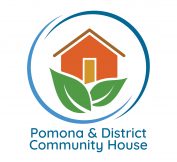
ARTICLE INFO
Article type: LIVED EXPERIENCE
Issue date: 18/05/2024
Issue No.: 2
Authors: Dr Michele Verdonck, Dr Kathryn Broadhouse
Original peer reviewed article: https://doi.org/10.1080/17483107.2023.2217859
WHY READ THIS ARTICLE?
Rationale: why did we do this work? More and more technologies that enable people to access the beach are being developed, but there is still little understanding of their real-world utility. This article shares findings, insights and first-hand accounts from Michele and the team’s studies to explore the use of these beach assistive technologies (AT).
Novelty: what’s new in this work? We know a lot about the health benefits regular access to the beach can provide and how mobility devices improve the lives of people with limited mobility. However, it is still unclear how, and if, the beach AT available today meets our needs and allows us all to access and enjoy the beach. This article pulls together the findings from the team’s work to provide you with an in depth, candid look at what to expect when using AT from local, first-hand accounts.
Relevance: Why does it matter to you? The supply of beach AT such as beach wheelchairs is really important, but it's also important to acknowledge that just supplying devices is not a solution itself. Take a first-hand look from locals on the Coast at the complexity of using beach AT beyond the feel-good factor of being at the beach. Understand just what it takes for some to get to the beach and learn about the AT and ingenious homemade inventions that make it possible.
Click to watch Michele introduce herself
This should be used as a text description for the video or the Call To Action:
This article is for 1. readers who may be thinking about trialling and using beach AT themselves and wish to learn more about what to expect. 2. For readers who wish to have more access to the beach but aren’t happy with their current beach AT equipment who are seeking inspiration to overcome the challenges. 3. For readers who wish to learn more about what it takes for people with mobility issues to enjoy the beach. 4. For carers seeking to learn more about beach AT.
AUTHOR’S TAKE
“For me running along the beach from Alexandra headland surf club over to Mooloolaba, out to the rock wall and back was my happy place. When I read this study carried out by Michele and the team I was immediately brought back to those moments. The feeling of the sun on my skin, the smell and sound of the sea and how they changed as you run round to the rock wall, the feeling in my lungs of the climb up Alex headlands and then the lightness on the way down.
Due to the international chaos of COVID I found myself in Spain when I was on my maternity leave. My son was 2 months old, I didn’t speak the language yet, my husband worked long hours and I had no friends of family in the same country. My situation had all the ingredients for a potential mental health meltdown. Luckily we lived near the beach! Even more fortunately, the local Spanish council in Andalucía have this odd obsession with rollering a 4m wide path along the entire stretch of sandy coast line about 2m from high tide. They do this every 2 weeks in the morning with a herd of tractors.
When I first saw them do this I thought it was a tremendous waste of fuel but then I realised this compacted 4m wide path of sand, accessible by board walks very 500m, was my life line. It meant I could access the beach and run with the buggy (and baby) on the sand next to the sea. It meant that even though I was hundreds of thousands of miles from my favourite run, I had a little piece of it, a way to connect to this foreign land and remain grounded during what can be for many women, a very isolating time in their lives.
Click to enlarge
Figure 1: taken at 9am on a February morning at Torre del Mar, Spain.
Access to the beach keeps me human. As a science communicator I get to work with some truly inspirational people. It has been an uplifting experience to work with Michele and team to understand more about the work that they are doing to ensure that everyone can access and enjoy the benefits of the best beaches in the world right here on the Sunny Coast. It has been even more inspiring to hear from the lived experience accounts of how locals with mobility limitations adapt to the challenge and utilise the latest technology to get them back to the beach.”
Dr Kathryn Broadhouse, Science communicator for HACA
BEACH LIFE BENEFITS
As Australians we highly value time spent near, and in, the big blue. Spending time at the beach is very much a part of our cultural identity. This hasn’t gone unnoticed. Most people around the world now think of Australians as easy-going surfers and beach lovers. This image is more than just a positive stereotype, with around 87% of Australians living within 50Km of the coast. More than 22 million of us now call the coast home. The good thing for us is that research shows that people who live closer to beach, rivers, lakes etc., are statistically more likely to be more active and benefit from all the health benefits that an active lifestyle brings. Accessing these outdoor water spaces is also showing therapeutic benefits, with researchers around the world now investigating the potential for beach time and beach-based activities to improve many mental health disorders such as PTSD.
ACCESS FOR ALL
Living on the Sunshine Coast, Michele (researcher of this study) is also a surf lifesaver and actively involved in patrolling the beach, coaching nippers and participating in surf sports. Her work marries two of her passions, assistive technology (AT) and the beach. Michele and the team work to improve access to the beach for everyone. Their research aims to inform future community inclusion programs and drive advocacy for acquisition of resources at a council level. In this issue of our newsletter we are going to look at some of that work and hear from first-hand accounts of people using beach AT on the Sunshine Coast.
We are going to delve into the reality of using AT to access the beach, the practicalities, the benefits and the pitfalls, from the people who know best. We will see from the team’s investigations that disability inclusion programs on beaches are complex and not just a question of providing Beach AT, but having the supporting infrastructure as well.
INTRODUCTION TO BEACH AT
What is beach AT and who uses it? When we talk about Beach AT we are talking about any piece of equipment that aids people with mobility limitations to access and take part in beach-based activities. This ranges from beach mats that allow wheelchairs, strollers and buggies onto the sand and into the water, to beach wheelchairs, motorised surfboards and boats with side access. As a reflection of our diverse and dynamic society on the coast, the mobility limitations that AT needs to cater for also covers a wide range of people and activities; from sleep deprived parents with strollers using the white noise of the waves to get a moments peace, elders who need assistance getting down to the shore to dip their toes in, parents who use wheelchairs who wish to play with their kids on the sand, to people with spinal cord injuries wanting to get back into the water.
What are the considerations and difficulties when accessing the beach with limited mobility? This is obvious, but sand gets everywhere and sea water is very salty. Both of these things are a mechanical nightmare, causing metal bearings and moving parts to rust, seize up and stop functioning. In addition, both dry and wet sand are very difficult to move over on feet let alone on wheels. Everyday wheelchairs and mobility aids are just not designed to access beach environments let alone get you in the water or allow you to participate in beach-based activities. Without AT designed for beach access, you face the decision of just not going to the beach at all, being stuck on the sand, and/or risk ruining your everyday wheelchair and or mobility aids.
Click to enlarge
Figure 2: Beach mat and chair at Noosa beach Original source for picture.
We will all, at some point in our lives need assistance to access the beach and we should strive to build a community that reflects our beach-based values and needs to do so.
For most of us our beach habits are also very varied and will change depending on what stage of our lives we are in. From playing in the sand with our kids or grandkids to water sports such as surfing and sailing. We need a variety of AT that can cater for all activities and needs for the diverse group of people that have mobility limitations. Currently the most common beach AT available are beach mats and beach wheelchairs (Figure 2). Beach mats are laid down in a pathway over the sand by the council and allow people on wheels to move over the beach. Beach wheelchairs have larger tyres so they don’t sink in the sand. Some are motorised but most are manually power. You can also purchase motorised attachments to modify your everyday chair for beach access.
This all boils down to the fact that AT can be very liberating but can also be seen as limiting and a hassle. AT is bulky and often requires other people to help out getting it in and out of cars and the water. Forward planning is also necessary if you want to borrow/ loan it at the beach. None of this allows for spontaneous trips to the beach and often means that people have to decide between overcoming the hassle and enjoying the benefits of beach access. So let’s hear from the local experts about what to expect when using AT, how to overcome the hassle, potential pitfalls and innovative home-made modifications to suit your needs to ultimately reconnect you with the beach and the sense of identity that that brings.
REVIEWERS COMMENTS
"This article is a lived experience look at people with disabilities having access to the beach. The article highlights what is available for people with disabilities and how creative they are at solving issues. It was really wonderful to see and in some places very touching. For those of us who can, we often forget what it is like to not be able to go the beach. This article is not just about technology, it is about strategy, it’s the emotional side as well."
METHODS
Michele and the team interviewed 14 people aged between 25 and 65 who self-identified as having mobility limitations and experience of using Beach AT to understand the research question - “What is the lived experience of using assistive technology to facilitate sandy beach-based leisure activities for people with mobility impairments in Australia?”. You can view the participant demographics in the table to the right. Participants have given consent to show all photos featured in this article.
Interviews were semi-structured, carried out and recorded online, and conducted by Leo in the research team who is trained in qualitative interviewing. Participants were invited to share photos and video of themselves at the beach to facilitate discussions around experiences using beach AT. The team used thematic analysis, typical in QUALitative research. QUANTitative analysis is numbers-based, countable, or measurable. QUALitative analysis is interpretation-based, descriptive, and relating to language. Quantitative analysis tells us how many, how much, or how often. Qualitative analysis, like the analysis here, can help us to understand why, how, or what happened behind certain behaviours.
Thematic analysis emphasises identifying, analysing, and interpreting qualitative data patterns to generate themes in conversations. Interview transcripts were analysed verbatim. Firstly, what was highlighted above all else is if we plan to use Beach AT we should be prepared to overcome pragmatic challenges related to size, storage, and propulsion. Secondly, we should have realistic expectations about the level of independence that we can achieve. We might have to use our initiative and ingenuity and adapt, such as selecting appropriate times for beach activities as well as making physical adjustments to the AT devices themselves. Managing expectations, researching current beach AT availability, having a plan and understanding what we want to achieve are key.
As the team wish to inform future government funded community initiatives this specific age range was selected so participants would also reflective those who would qualify for National Disability Insurance Scheme (NDIS) funding which could include Beach AT (thus excluded those over 65). However, the insights and knowledge gained from the participants can be applied to all who use and/or want to use Beach AT. See end of article for notes around NDIS funding.
QUESTIONS & ANSWERS
REVIEWERS: We would like to know if 14 is a good sample size and what are the sample size considerations for this type of qualitative, thematic data analysis?
RESEARCHERS: Great question to discuss and educate about research design. The sample size is not as important as the quality of the interviews and how much depth is in each interview and the richness of the quotes. In this case 14 was more than enough because of the quality of the data we received. We could possibly have stopped after interviewing 9 people as we were not finding ‘new’ themes from then on. The following interviews stood to confirm what we were already finding.
RESULTS
From the thematic analysis of the participant’s semi structure discussions, three major themes were identified. We are now going to run through 1. responses to using Beach AT, 2. the practicalities, and 3. the meaning it brings to people’s lives.
1. RESPONSES TO USING BEACH AT
A. I didn’t think it was possible. For many of the participants, until they found opportunities to try Beach AT via surf lifesaving clubs they had been excluded from beach activities post injury, illness, or impairment for 18 months to 15 years. “[After my injury] I thought that was it. No more beach” (Adrian). From the analysis in this study it was clear that organised opportunities to trial equipment created by occupational therapists, rehabilitation services, advocacy groups and specialised accessible resorts are a crucial step in someone’s journey back to the beach. These organised opportunities were when many of the participants first realised it was possible to enjoy the beach again.
“I really didn’t think I'd be able to go back into the water” [until my occupational therapist] told me about this Freedom Trax. So, … arrange as many trials of equipment as possible. Because it wasn’t until [then] that I was like, ‘Yeah, okay, this could work’” (Savannah).
“The first time I found a beach mat, I was just overwhelmed by it. Thank God, someone’s thought of this. … to be able to do something … that I thought was gone” (Gayle).
B. Adaptations to AT limitations. After trialling the available Beach AT in your area you might find that there isn’t one thing that fits your specific needs all of the time. Some of the study’s participants find it easier to compromise their everyday wheelchair to fulfil their beach goals despite acknowledging the negative impact of sand and saltwater on their everyday chairs rather than hire or buy their own. You might feel the same way.
“The chair needs to live your life, not you live accordingly to suit your wheelchair”. (Jimmy).
Additionally, after seeing what is available and identifying your goals at the beach you might think of ways to modify existing Beach AT. Wil has filled his Canadian crutches with foam pieces, attached pool noodle sheaths and added rubber disc feet to traverse the sand. Douglas has designed foam steps to aid water transfers. Martin has printed a 3D drone joystick to enable him to ‘virtually’ participate in family walks along the beach. Aidan adapted a car bike rack to carry a large power wheelchair rather than requiring a trailer. You can see photos of the adaptations below.
C. Not everybody wants to own AT. Many participants feel that they don’t want to own Beach AT due to the fact that beach wheelchairs are difficult to propel and “bulky” to transport or store. The initial cost of purchase and ongoing maintenance could also be a concern given that you may not use the AT regularly.
If you are looking to trial some Beach AT, the link below gives details of beaches on the Coast that offer Beach AT for hire.
REVIEWERS' SUGGESTIONS
Community project
"The home made modifications that some of the participants have come up with have really inspired us. When we read this section of the article is was abundantly clear that we need a Community Makers Space where people with all different expertise can meet and create beach AT modifications that meet their individual beach goals. If there is enough people who want to help – Men’s/Women's shed's, local councils and community centres, this could be a very impactful, intergenerational, longterm, grass roots project."
Start up idea
"After seeing the simple but brilliant modifications that the participants had come up with we can also see how these could be useful for many people with mobility issues that don’t qualify for disability aid. This idea of simple modifications to existing tech could even make a nice startup that has potential."
Funding grass roots initiatives
'"There is so much potential for a community lead initiative here. This potential Maker Space may even qualify for social isolated funding as is would need a driver to start it."
RESEARCHERS' RESPONSE
"We had a similar response when working on this study! We are going to try and kick start some of these ideas by providing a platform on HACA where readers can send in videos of their homemade beach AT creations, how they made them and how they use them. We will then host them on a our The A-Z of Beach AT page. We are also going to start a new project surveying the Sunshine Coast's beaches to create a comprehensive map of beach AT complete with local knowledge and reviews so its easier to plan a beach trip and identify where improvements are needed."
If you would like to get in touch about about these, or any other ideas you have from reading this article you can contact us below.
2. PRACTICALITIES WHEN USING BEACH AT
This isn’t going to be easy, be prepared to overcome some challenges to gain the benefits of going to the beach again.
A. Using AT requires other people to help: Even when you have all the gear going to the beach requires some level of assistance. Soft sand can compound your disability by reducing mobility and or independence. Further assistance is required for: packing AT in the car; changing power chair tyres; pushing beach wheelchairs on the sand; aiding transfer in and out of the water or having someone on hand in case things go wrong such as being bogged in the sand.
“Theoretically, I can now go on the beach (using AT), [but] I'm either going to have to have [my partner] … with me or somebody else who can lift the [AT] (off road wheelchair power track attachment) because it’s more than 25 kilos” (Savannah).
Reviewers were really excited about the potential for a grass roots community project where people share their beach assistive technology modification ideas and help others do the same.
B. AT impacts spontaneity: Beach AT requires some level of planning. Even if you prefer to be spontaneous be prepared to need to organise a support worker, friend, or family member in advance. It is also really important to do your research; research beach locations, public transport, beach access, disability parking and change rooms, beach mat hours and booking beach wheelchairs via websites, social media forums and or phone in advance.
Savannah has a beach day checklist which includes charging, packing, and transporting AT.
“Usually on a Thursday, I'm already looking at the next week … that I know what I'm going to do and how I'm going to deal with it,”.
C. AT limitations and tradeoffs. The perfect piece of AT that does everything doesn’t exist. “I'm yet to find the perfect piece of AT. Some equipment that is no good for me might be perfect for the next bloke. Depends [on] what they do and where they go” (Dane). You currently have to weigh up your desire to independently self-propel and to meet your leisure goals against environmental demands of the sand or ocean and feature limitations of available AT.
“With my [power track system], I can move around independently on the beach. …The limitation to it is that it’s an electronic piece of equipment and electronics and salt water don’t go well together. [In a manual chair] I could go out to waist height … get wet and get amongst it … But then the trade-off is I can’t chase the kids around the beach.” (Adrian)
Beach mats can be life changing and “fantastic idea”. However, doing your research is key as unfortunately, at some beaches they have been plopped down without much thought for the user (*“uh hum”* council this is one for you…).
“At some beaches they are provided without shade, or a passing lane, parking or turning bay, or are too short to get you down to the hard sand, which is where you need to get to for you to be able to be independent” (Lachy).
Everyone is different and we all have different ability levels, different goals and different activities we want to do on the beach. Furthermore, these needs and goals are going to change day to day and year on year. Your beach needs will evolve over time with progressive illnesses, emerging new technology and expanding leisure interests.
“It’s about having a range of different equipment for a range of different ability levels, body shapes, sizes” (Shane).
D. AT use differs in water. There is a clear line between water and sand. These environments pose different challenges and opportunities and you may need to use Beach AT in a variety of creative combinations. Participants spoke about using standard watercraft, paddles, wetsuits, ankle weights, as well as customised personal flotation devices to access the water. You can also use sea scooters to increase your time in the water and reduce fatigue, motorised surfboards and Personal Flotation Device when surfing to minimise risk of drowning and water shoes to protect skin integrity.
3. THE SIGNIFICANCE OF BEACH AT
So you have done your research, you have found the beach AT that suits most of your beach goals and you have a plan, what experience awaits you by the waves?
A. AT connects me. For many of the participants Beach AT isn’t just equipment. The team’s investigations revealed it has therapeutic properties as well. It provides access to beach leisure that are grounding, spiritual experiences that connected people to their surroundings. It enables a return to leisure activities such as swimming, surfing, dog walking, boating, fishing, and outdoor sculptures by the sea. Beach AT gets people out of the house, and increases opportunities to participate more in the community and with friends.
“I actually put a foot down on the sand!” (Jack)
“It’s changing from a 2D world restricted to the boardwalk, to a 3D world where you’re a part of it, rather than just looking at it [the beach]. I thought of [the self-balancing two-wheel power wheelchair] as a mobility device, but it’s actually this amazing mental health device as well …[because] it’s a huge lift, to be outdoors”. (Adrienne)
“The way the water feels on my skin”, smelling the ocean breeze, feeling the sea spray, and hearing the “roar of the ocean and the crashing of the waves”. “You’re part of society, […] you’re at one with nature again, and that’s what we’re all trying to do, connect with our environment”. (Douglas)
When reading this article we thought of others that would benefit from these beach AT modifications - Stroke patients etc. or people that haven’t officially been classified as disabled and don’t qualify for beach AT funding.
We think it would be a great idea to create a lived experience page on HACA where people can read and submit their own experiences. To show what is feasible, HACA could launch videos of people showing their own modifications
Many of the participants felt that beach access was a human right and that heading to the coast for a day out was “part of Australian culture” allowing “a normal life”. It can, “bring back good memories” and for some it is integral to building memories with their own children.
B. AT impacts my identity. Beach AT was described as “makes life worth living”. Accessing the beach to participate in leisure through the use of Beach AT, was described as enabling participants to reconnect to their sense of self, either as an outdoors person, a water person, an athlete, or an active fun parent.
“My [motorised manual wheelchair track attachment] enables me to move around on the beach and chase a cricket ball or chase the kids around or build sandcastles”. (Dane)
Gayle who uses a beach mat and manual chair to reach the ocean said, “[The beach] makes me feel normal, alive. […] I'm not disabled in the water”.
“It just reconnects me with the way life used to be before I had the accident. Without the [prosthetic] legs, I probably still wouldn’t be going down to the beach”. (Jacko)
“I grew up on a beach, so it’s actually my centre. It’s my soul. It’s something that is a part of […] who I am and identify with”. (Katie)
When Beach AT works it can lead to a sense of empowerment, by enabling a return to ‘normal’. However, when AT requires other people to operate it, if it is unavailable, or cannot be mastered, this can be limiting or excluding as you can become static onlookers. In these instances, people can “kind of end up the look-after-the-gear person” or “I’m now a bystander of my world”.
“I need to make this look flawless … if I can’t do that then people will think I have a disability when I'm trying to just live my life and show people that I can do anything I want to do. [So] If it can’t make it look flawless, then I don’t want to do it”. (Jimmy)
C. AT attracts attention. The attention that Beach AT draws from strangers is polarising. These unwanted interactions can make some feel like a target for attention, making them feel embarrassed by being the “centre of attention”. Unfortunately, some can even be thoughtless and rude to “hindering” and “hateful”.
However, some welcome these interactions as opportunities to receive help when bogged in the sand, or when lifting their chair onto the back of a car. It can be a confidence boost.
“While we’re waiting for the waves, you just have a bit of a chat, … I've got some rubber blocks made, foam blocks that I kneel on, to protect my legs. …. It’s always a discussion point. [Or] they see me using [my customised Canadian crutches] as I come in or out of the water and … say, ‘That’s a great idea, how did you make them?”. (Wil)
“Every time without fail, we go to the beach, there’ll be someone that comes up… ‘Oh, how good is that you get down onto the beach’. … I don’t mind […] I see it in an educational type, disability awareness type way”. (Dane)
CONCLUSION
The work carried out by Michele and the team is what’s known as qualitative research. The data are not a bunch of numbers we can carry out quantitative statistics on which then provides a neat answer. Instead the data are real, complex conversations that are a lot harder to analyse. By systematically analysing discussions from lived experiences into the three themes above we can start to unpack the complexities of accessing the beach with mobility limitations and the realities of using the current beach AT available.
In recent years there has been an increase in variety of beach AT available on the market and provided by councils. This rising trend is partly driven by research in this area, which raises awareness and identifies the shortfalls for further development. It is clear from the investigations laid out here that there are still challenges related to size, storage, and propulsion, but the participants have shown that these can be overcome through ingenuity.
The therapeutic and health benefits that current beach AT provides is clearly evident in this study, enabling connections to social groups and contributing to one’s identity as a beachgoer. However, the unique nature of sand, water, and salt environments coupled with our Aussie cultural connection to the beach, provides distinct yet exciting engineering challenges. Because of this, we have the potential to lead the way in Beach AT research and innovation. We now need technology to catchup and keep up with our dynamic and diverse users of beach AT.
“In an ideal world a range of AT would be available 24/7 to borrow or hire at all patrolled beaches by anyone in the community who may benefit from it.”
FUTURE WORK AND HOW TO GET INVOLVED

Michele is on the Board of the Australian Rehabilitation and Assistive Technology Association https://www.arata.org.au/ ARATA and this year Beach Access and AT is a hot topic for the annual Australian Assistive Technology Conference to be hosted by ARATA on the Gold Coast. Anyone is welcome to sign up and attend and more information can be found at https://aatc2024.com/.
SAVE THE DATA
We will be posting the highlights from the conference here on HACA
COMMUNITY INFORMATION
Here is a link to the council site about beach AT. They fund the wheelchairs at some beaches.They note the clubs have equipment and when the volunteers are on duty and it is fairly easy to get a chair. During the week paid lifeguards can also help, but only if they have capacity. General safety is the primary issue.
You can ‘hire’ (borrow) a chair from here
https://www.compassinc.org.au/disability-services/waterwheels/
Here is an article about the beach AT at Noosa heads main beach
https://www.noosa.qld.gov.au/news/article/1418/access-mat-ensures-everyone-can-enjoy-a-trip-to-the-beach
Here is a review of the beach AT at Noosa heads main beach
https://wheeleasy.org/explore/noosa-heads-main-beach/sunshine-coast/beach-wheelchair
REVIEWERS QUESTIONS: Could Michele provide a bit of information on what is funded in the NDIS scheme and if there are any funding schemes for +65?
RESEARCHER'S RESPONSE: "NDIS is governed by “reasonable and necessary” not specific devices or specific outcomes. This means there are no rules for what devices may or may not be funded in an NDIS package. If beach AT is to be funded that would require including a beach access goal which requires the AT in an approved NDIS plan. On a practical level this is challenging as the NDIS goal may be viewed as not ‘necessary’ or not ‘reasonable’. This is always on a case by case basis so it may appear that there are inequalities in the funding but funding needs to be considered in a wider picture of each person’s specific goals related to their context. As an occupational therapist I may support a client to have a NDIS goal which includes daily beach access if they were/are daily beach users who live next to a beach. A person who goes to the beach infrequently is less likely to have a ‘reasonable’ goal which supports personal ownership of a large expensive beach wheelchair.
Funding for +65s see https://www.cotant.org.au/wp-content/uploads/2022/12/2022-Australian-AT-Equity-Studies-Final-Report.pdf - appendix 2 for full list of possible funders.
This report introduces a whole different discussion which is highly relevant to the group; there is a national campaign to advocate for AT for older persons given they cannot access the NDIS
Show and share your creations!
We want to see your homemade beach AT adaptations and creations. Send us a short video or email detailing what you have made and how you use it at the beach and we will host it on our The A-Z of Beach AT page
Email:HACAinfo@usc.edu.au

HACA acknowledges the Traditional Owners of the land on which we conduct our activities. We pay our respect to their Elders past and present and extend that respect to all Aboriginal and Torres Strait Islander peoples throughout Australia
COPYRIGHT © {2023} - HACA
